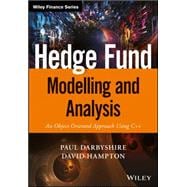Low interest rates, overcrowded markets and greater regulatory oversight are just some of the many reasons it is close to impossible for hedge funds to draw competitive returns. The solution for many hedge fund managers, quantitative investment analysts and risk managers is to adopt new technologies, platforms and programming languages to better manage their risks and maximise the benefits of their return profiles.
Hedge Fund Modelling and Analysis is a full course in the latest analytic strategies for hedge fund investing, complete with a one-of-a-kind primer on both C++ and object oriented programming (OOP). Covering both basic and risk-adjusted performance measures, this practitioner's guide enables you to manage risk easily and make the most of key statistics with simple and advanced analysis techniques. This highly anticipated third book in the widely used Hedge Fund Modelling and Analysis series is the only guide available for applying the powerful C++ language to revolutionise hedge fund trading. Even if you've never worked with code before, the focused overview of C++ gives you everything you need to navigate the technical aspects of object oriented programming, which enables you to build sophisticated analysis programs from small units of reusable code. This book is your breakthrough introduction to winning with hedge funds in the new reality of trading.
Jumpstart your new approach to beating the markets with:
- All the guidance and hands-on support you need to use quantitative strategies to optimise hedge fund decision-making.
- Illustrative modelling exercises and worked-out problems demonstrating what to expect when assessing risk and return factors in the real world.
- A companion website offering additional C++ programs, algorithms and data to download.
Make reading Hedge Fund Modelling and Analysis your new routine and gain all the insight and relevant information you need to beat the markets.








